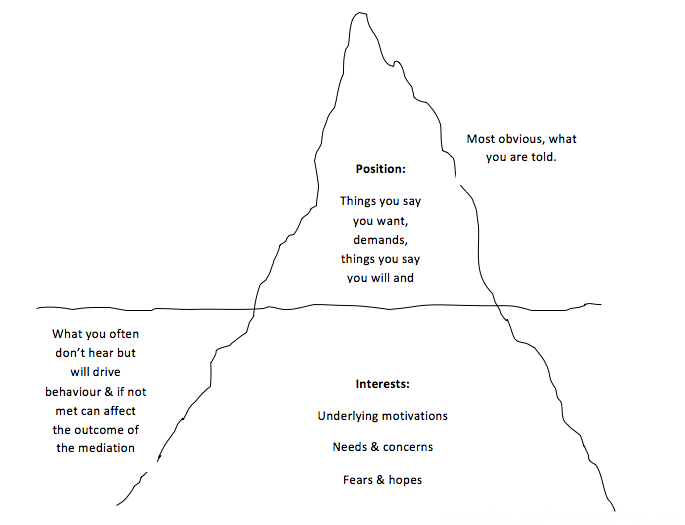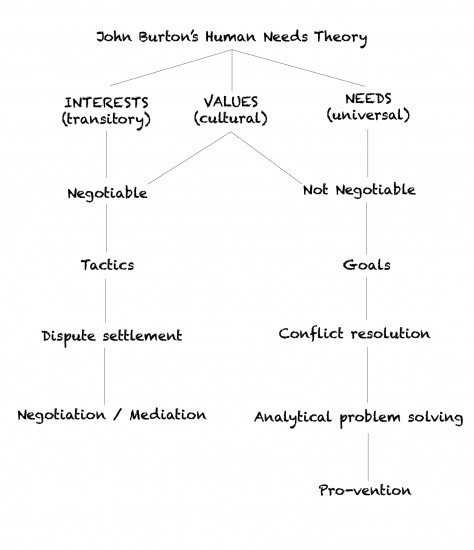Today I’m teaching my class some conflict resolution techniques & tips… so I thought I’d share with you.
The aim of Galtung’s method is to transcend, to go beyond, the original conflicting interests, to achieve more than each party’s stated goals. Not either/or, but BOTH/AND…
Mediation is usually done with both parties present. For deep conflicts, the Transcend method recommends the mediator meet with one party at a time. Conducted in a conversation style setting – the hope is to join both parties together in a creative search for a new reality.
There are two psychological processes that this involves: (1) cognitive expansion and reframing; (2) an emotive shift in cathexis.

Conflict Iceberg from Quadan (2011).
We are aiming to identify the hidden motivations, needs and fears… these can then be divided into interests, values and needs… Burton’s Human Needs Theory (below) helps us to consider the differences and how to deal with what we identify:

Quadan’s Golden Rule of Mediation: The mediator owns the process and the parties own the content. The mediator doesn’t determine the outcome, parties do.
The point of departure is usually dualistic discourse reflecting a polarized conflict formation: the Other and his/her position are viewed negatively, and the Self and own position glorified. [Note that the following steps and communication tips are a culmination of the sources referenced at the bottom of this page.]
First round:
1. DIAGNOSIS: One of the parties, usually the one who initiated the mediation, is asked to briefly state his/her negative goals (fears/concerns) and his/her positive goals (hopes/expected outcomes). When did this go wrong and what could /should have been done at the time? The past is less threatening than what is unfolding before one’s eyes.
2. PROGNOSIS: Mediator reads back the parties’ stories as told by the parties. In no way try to dissuade the party from their goals, but probe more deeply into the nature of the goals. The broader the vision, the more likely new perspectives can be developed. And how do you think this is going to develop further? – all now anchored in what happened and what could have been done.
3. DEEPER DIAGNOSIS: Need to come to the party’s own diagnosis of the ‘situation’ and what he thinks the other parties’ diagnoses look like. What is underlying all of this?’ Take your time, be sure each theme has more or less been exhausted before moving on to the next.
4. NEW COGNITIVE SPACE: Party and conflict worker together construct a new cognitive space, framing the old goals as suboptimal, simplistic, and formulating broader goals. Don’t be so modest, go in for something better than what you used to demand! Explore whether all parties embrace the same points in the new cognitive space
5. THERAPY: What can be done about it? Then we come to the creative element: how can the needs of both parties be transcended?
E.g. for thinking outside the square: sexual infidelity looks different when four other ways of being unfaithful are considered: of the mind (secret love), of the spirit (no concern for partner’s life project), socially (no social support), and economically (secret account)
Question of what each party thinks is going to happen, and what he thinks the other parties are expecting.
Imagine things turns out the way you think they will: you win. How will the others react? Recognising the possibility of endless revenge cycles may spell disaster to Self. ie What would happen if we proceed along the following lines? How would life be for your children, grand children?
Second round:
6. Hand back to the parties, probe for sustainability together with the parties. What could make outcomes of these types stick? What are the vulnerabilities, the weak points?
7. Identify concrete steps for all parties.
If both parties reach conclusion that transcendence is preferable to other possibilities (continued struggle, withdrawal, compromise) then that is good, but even better if the transcendence withers away the other outcomes.
Ideally the solution comes from an inner conviction or inner acceptance. Often realists limit themselves to two forms of power: punishment and reward. Power from within individuals is far more effective than power over them. A good agreement is reversible. Only do what you can undo.
References:
Quadan, A & Dan, K (2011) Community Mediation: Theory and Practice — Course Manual. Centre for Peace and Conflict Studies, University of Sydney
Galtung, J & Tschudi, F (2001) “Crafting Peace: On the Psychology of the TRANSCEND Approach” in Christie, D.J. Sagner, R.V & Winter D.D. (eds) Peace, Conflict and Violence Upper Saddle River, NJ: Prentice Hall.
Galtung, J (2007) “Peace by Peaceful Conflict Transformaiton – the TRANSCEND approach” Galtung, J & Webel C (eds) Handbook of Peace and Conflict Studies, New York: Routledge
Horowitz D & Laksin J Conflict Resolution Skills Workshop
No Comments Yet